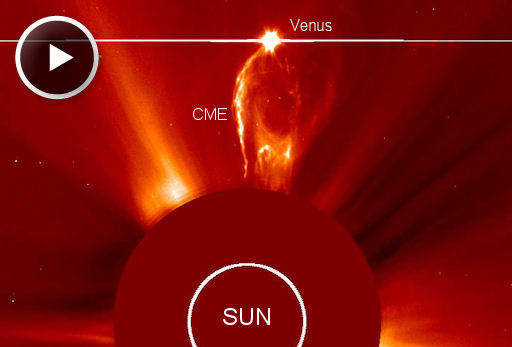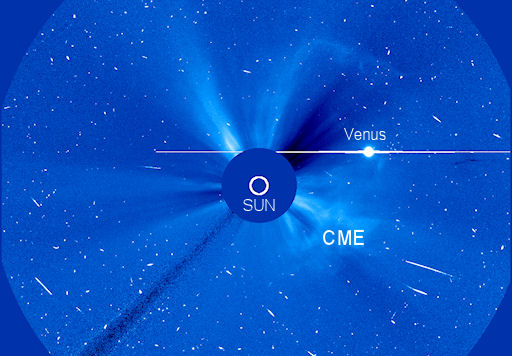CME (Coronal Mass Ejection) vom 16. August 2011
VENUS AND THE SOLAR STORM: (Note: No planets were harmed in the production of this movie.) Yesterday, the Solar and Heliospheric Observatory witnessed a spectacular explosion on the sun that seemed to pass perilously close to Venus. Did the cloudy planet survive? Play the movie for answers:

Credit: Solar and Heliospheric Observatory, C2 coronagraph
As the movie shows, the CME passed harmlessly. There was no collision, and it wasn't even close. Although Venus seems to be near the sun, the planet is actually more than 100 million kilometers away. The two bodies are "in conjunction" this week as Venus moves almost directly behind the sun. Because of this arrangement, more CME-Venus conjunctions are possible in the days ahead. Check SOHO for the latest images.
Sonnenfleck weiter vergrössert (7. August 2011)

BIG SUNSPOT GETS BIGGER: Behemoth sunspot 1263 has almost doubled in size this weekend. A 28-hour movie from NASA's Solar Dynamics Observatory shows the spot developing a tail that has added some 50,000 km of length to the active region. This development may increase the likelihood of a strong flare.
Sonnenfleck 1263 (Behemoth) hat dieses Wochenende seine Grösse nahezu verdoppelt. Behemoth hat zu seiner aktiven Region einen Schweif von nahezu 50.000 km entwickelt. Diese Entwicklung erhöht die Wahrscheinlichkeit einer stärkeren Sonneneruption.
Starke Sonnenaktivität seit 3 Tagen (2-4.August 2011)
STRONG SOLAR ACTIVITY: For the third day in a row, active sunspot 1261 has unleashed a significant M-class solar flare. The latest blast at 0357 UT on August 4th registered M9.3 on the Richter Scale of Flares, almost crossing the threshold into X-territory (X-flares are the most powerful kind). The number of energetic protons around Earth has jumped nearly 100-fold as a result of this event.
The eruption propelled a bright coronal mass ejection (CME) toward Earth. Click on the image to view a movie of the expanding cloud recorded by the Solar and Heliospheric Observatory:

Note: The many speckles in this movie are caused by energetic solar protons hitting the camera.
Moving at an estimated speed of 1950 km/s, this CME is expected to sweep up two earlier CMEs already en route. Analysts at the GSFC Space Weather Lab say thecombined cloud should reach Earth on August 5th at 13:55 UT plus or minus 7 hours: "The impact on Earth is likely to be major. The estimated maximum geomagnetic activity index level Kp is 7 (Kp ranges from 0 - 9). The flanks of the CME may also impact STEREO A, Mars and Mercury/MESSENGER." High-latitude sky watchers should be alert for auroras
 Disclosure - Enthüllung des UFO Phänomens/Freie Energie
Erstkontakt - Begegnung mit unseren Sternengeschwistern
Disclosure - Enthüllung des UFO Phänomens/Freie Energie
Erstkontakt - Begegnung mit unseren Sternengeschwistern



